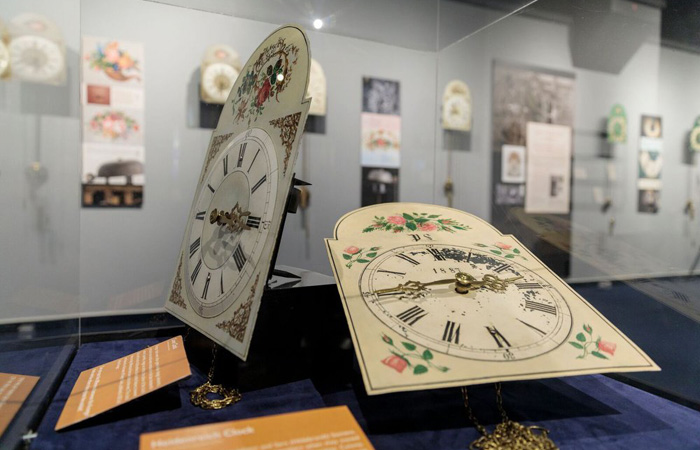The Art of Mennonite Clocks, our new exhibit in the Gerhard Ens Gallery, was formally opened to the public with a ceremony on Manitoba Day, May 12. A crowd of enthusiastic guests heard introductory comments by Andrea Dyck, Curator at Mennonite Heritage Village (MHV) and manager of this exhibit, and Liza Kroeger, Director of the Kroeger Clocks Heritage Foundation, a partner in this exhibit. These were followed by stories about how some of the clocks in this exhibit happen to be in Canada today. Guests then spent time exploring the exhibit, which consists of more than 30 clocks and interpretive panels that tell the stories about them.
The Kroeger Clock Heritage Foundation has been established by the family of the late Arthur Kroeger, a descendent of the Kroeger clock-making family. Mr. Kroeger was a friend of MHV and the author of Kroeger Clocks, published by MHV and currently sold at Village Books and Gifts in the Village Centre. We are grateful for the resources this foundation has brought to the new exhibit. We also appreciate the support of the MHV Auxiliary and Manitoba Heritage Grants, which also helped make it happen.
Some of the clocks in this exhibit have come from our MHV collection, some from the collection of the Manitoba Museum, and some from individuals who have graciously loaned them to us. We are thankful for all of these contributions, which together have resulted in an outstanding exhibit.
One of the things I find intriguing when I consider these clocks is the fact that so many were brought to this country by people immigrating, often under very adverse and stressful circumstances. It’s hard to imagine a more challenging possession to pack and transport for weeks, or sometimes months, of travel.
Some of the stories we heard on Saturday provided details of the arduous journey the clocks (and their owners) had to endure. One of our storytellers, as a young boy, had his family’s clock stored under his seat on the horse-drawn wagon traveling for months from Russia to Germany. Another said that when their clock was hung on the wall, their new house felt like a home.
These clocks had such high value to the families who owned them that they went to unusual lengths to keep them in their possession. I wonder what made the clocks so important. Was it their economic value? Were they heirlooms handed down from previous generations, carrying more sentimental value than economic value? And how does my own value system today align with the value systems of my forebears who brought such clocks with them? Thanks to Andrea Dyck and her team of talented people, I and many others will now have a year to reflect on these questions and talk about them with our families, friends and acquaintances.
The Art of Mennonite Clocks will be on display in the Gerhard Ens Gallery until about this same time next year. This stunning exhibit is well worth the trip (or several trips) to MHV to explore it.




